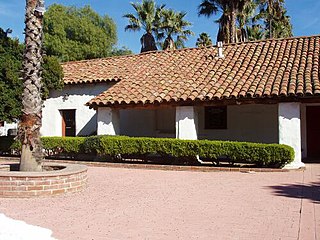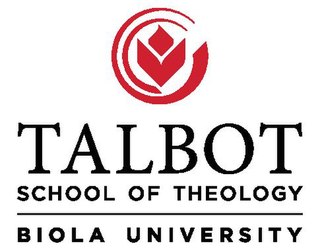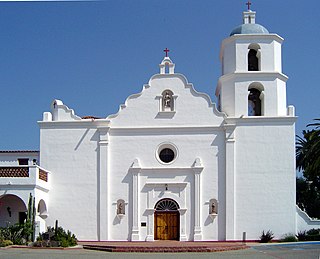
Mission Santa Barbara is a Spanish mission in Santa Barbara, California, United States. Often referred to as the 'Queen of the Missions', it was founded by Padre Fermín Lasuén for the Franciscan order on December 4, 1786, the feast day of Saint Barbara, as the tenth mission of what would later become 21 missions in Alta California.

Mission San Luis Rey de Francia is a former Spanish mission in San Luis Rey, a neighborhood of Oceanside, California. This Mission lent its name to the Luiseño tribe of Mission Indians.

Vanguard University is a private Protestant university in Costa Mesa, California. It was the first four-year college in Orange County. Vanguard's required core curriculum includes courses on American politics and history, theology, fine arts, and public speaking.

The San Antonio de Pala Asistencia, or the "Pala Mission", was founded on June 13, 1816, as an asistencia or "sub-mission" to Mission San Luis Rey de Francia, some twenty miles inland upstream from the latter mission on the San Luis Rey River. Pala Mission was part of the Spanish missions, asistencias, and estancias system in Las Californias—Alta California. Today it is located in the Pala Indian Reservation located in northern San Diego County, with the official name of Mission San Antonio de Pala. It is the only historic mission facility still serving a Mission Indian tribe.

The Las Flores Estancia was established in 1823 as an estancia ("station"). It was part of the Spanish missions, asistencias, and estancias system in Las Californias—Alta California. Las Flores Estancia was situated approximately halfway between Mission San Luis Rey de Francia and Mission San Juan Capistrano. It is located near Bell Canyon on the Camp Pendleton Marine Corps Base ten miles south of the City of San Clemente in northern San Diego County, California. The estancia is also home to the architecturally significant National Historic Landmark Las Flores Adobe, completed in 1868.
Westminster Seminary California is a Reformed and Presbyterian Christian seminary in Escondido, California. It was initially a branch campus of Westminster Theological Seminary in Philadelphia until 1982 when it became fully independent. It has thirteen full-time faculty members and enrolls approximately 155 full-time students.

The Luiseño or Payómkawichum are an Indigenous people of California who, at the time of the first contacts with the Spanish in the 16th century, inhabited the coastal area of southern California, ranging 50 miles (80 km) from the present-day southern part of Los Angeles County to the northern part of San Diego County, and inland 30 miles (48 km). In the Luiseño language, the people call themselves Payómkawichum, meaning "People of the West." After the establishment of Mission San Luis Rey de Francia, "the Payómkawichum began to be called San Luiseños, and later, just Luiseños by Spanish missionaries due to their proximity to this San Luis Rey mission.
Bahnsen Theological Seminary was a Calvinist theological training institution, founded in 1997 and based in Placentia, California. It was most notably associated with Greg Bahnsen and Kenneth Gentry. It served as the degree granting division of the Southern California Center for Christian Studies. It offered instruction worldwide by correspondence, as well as courses presented locally. BTS offered four master's degree programs; Master of Divinity, Master of Christian Studies, Master of Apologetics, and Master of Philosophy.
Mission San Fernando Velicatá was a Spanish mission located about 56 km (35 mi) southeast of El Rosario in Baja California, Mexico. The mission was founded in 1769 by Franciscan missionary Junípero Serra and was the only mission founded by Franciscan missionaries in what is now Baja California.

Talbot School of Theology is an evangelical Christian theological seminary located near Los Angeles. Talbot is one of the nine schools that comprise Biola University, located in La Mirada, California. Talbot is nondenominational and known for its conservative theological positions, particularly its historical adherence to biblical inerrancy.

The Pala Indian Reservation is located in the middle of San Luis Rey River Valley in northern San Diego County, California, east of the community of Fallbrook, and has been assigned feature ID 272502.
Pablo Tac was a Luiseño Indian and indigenous scholar who provided a rare contemporary Native American perspective on the institutions and early history of Alta California. He created the first writing system for Luiseño, and his work is the "only primary source of Luiseño language written by a Luiseño until the twentieth century."

The Franciscan School of Theology (FST) is a Roman Catholic graduate theological school at the University of San Diego, a private Roman Catholic research university in San Diego, California. FST is owned and operated by the Province of Saint Barbara of the Order of Friars Minor and also has academic and other affiliations with USD. FST "is the only freestanding Franciscan graduate theological school in North America dedicated to the Franciscan intellectual tradition."
Rancho Monserate was a 13,323-acre (53.92 km2) Mexican land grant in present-day San Diego County, California given in 1846 by Governor Pío Pico to Ysidro María Alvarado. The grant extended south and east of the present day Fallbrook down to the San Luis Rey River. The grant was bounded on the west by Pico's Rancho Santa Margarita y Las Flores.
Rancho Buena Vista was a 2,288-acre (9.26 km2) Mexican land grant in present day San Diego County, California given in 1845 by Governor Pío Pico to Felipe, an Indian. The name means "good view" in Spanish. The grant was south of San Luis Rey River and Rancho Monserate and encompassed present day Vista.
Rancho Little Temecula was a 2,233-acre (9.04 km2) Mexican land grant in present-day Riverside County, California given in 1845 by Governor Pío Pico to Pablo Apis. The grant was one of the few held by indigenous people. The grant is south of present-day Temecula and is bordered on the north by Temecula Creek. At the time of the US patent, Rancho Little Temecula was a part of San Diego County. Riverside County was created by the California Legislature in 1893 by taking land from both San Bernardino and San Diego Counties.

Rancho San Jacinto Nuevo y Potrero was a 48,861-acre (197.73 km2) Mexican land grant in present-day Riverside County, California given in 1846 by Governor Pío Pico to Miguel Pedrorena. At the time of the US Patent, Rancho San Jacinto Nuevo y Potrero was a part of San Diego County. The County of Riverside was created by the California Legislature in 1893 by taking land from both San Bernardino and San Diego Counties. The grant encompassed present-day Lake Perris.

Rancho Temescal was a farming outpost of Mission San Luis Rey de Francia, one of the 21 Franciscan missions established in California by Spain during the late 18th and early 19th centuries. The Mission was located on the coast where Oceanside, California, is today. The Rancho was settled in 1819 by Leandro Serrano, and became the first non-native settlement within the boundaries of what would become Riverside County, California.
Veritas International University (VIU) is a non-profit accredited Christian university in Santa Ana, California. It will relocate to Albuquerque, New Mexico in 2023. Founded in 2008, the university began as a seminary before transitioning to a university with the addition of undergraduate and post-graduate degrees. The university now offers doctoral degrees as well.










